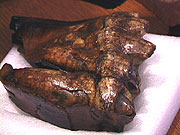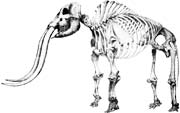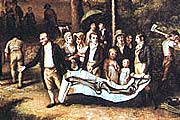Mammoth
 |
| This is the molar of a mastodon excavated in Big Bone Lick, KY. Jefferson owned this tooth. |
| |
 |
| Reconstructed skeleton of a mastodon by Jefferson's friend, Charles Willson Peale. Image courtesy of Academy of Natural Sciences. |
Bones and teeth from giant elephant-like creatures called mastodons, often referred to as "mammoths," had been found in several locations across the northern part of the United States in the late 1700s. The large size of the fossils implied huge animals many times larger than any known elephant.
Mammoths and mastodons are two different species but Jefferson and others of the time spoke of them in the same terms. Paleontology at the time was not advanced enough to distinguish a difference between the two.
The existence of such mammoth animals excited the interest of many people, including President Jefferson, who summarized what he knew about mammoths in 1780 in his Notes on the State of Virginia. In 1797 as president of the American Philosophical Society, he and others organized expeditions to find "one or more complete skeletons of the mammoth" and other unknown animals. Later Jefferson used his own funds to hire William Clark to look for mammoth fossils along the Ohio.
We now know that mammoths and giant sloths became extinct about 10,000 years ago, but Jefferson thought that Lewis might find them alive and well in the unexplored west. First, Jefferson knew of Indian tales that suggested that mammoths in particular still lived in the distant West. In addition, Jefferson and many others rejected the possibility that sloths and mammoths could be extinct based on the idea of the "great chain of being," in which everything in Heaven and on Earth were links in a beautiful, harmonious chain of creation. Should any link disappear, the chain would be broken and chaos would follow.
However, the question of whether any species of plant or animal could become extinct was being heatedly discussed in the early 1800s. French paleontologist Georges Cuvier and others were just getting started on their work that eventually established the reality of extinctions.
As it was, Lewis and Clark found no traces of living mammoths. The extinctions had indeed happened.
next > | 



